Why Pompeii? The Allure of an Ancient City
Pompeii, an ancient city preserved in time, provides a unique window into the way of life of those who lived there prior to to Mount Vesuvius’ devastating eruption in 79 AD. Visitors from all over the world are still enthralled by the vivid glimpse of Roman life that its well-preserved ruins which range from opulent palaces with paintings to lively marketplaces offer.
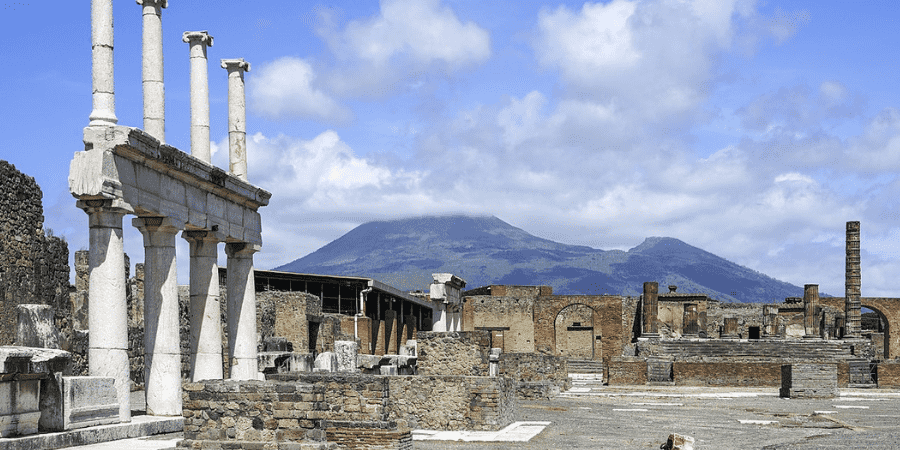
A journey into the past, a Rome to Pompeii Day Trip gives visitors to Italy the opportunity to discover historic buildings, stroll down cobblestone streets, and engage with a society that has persisted for centuries. The attraction of Pompeii is its capacity to take tourists to a world that is long gone yet amazingly alive in its details, regardless of whether you are a history buff or just interested in the past.
How to Plan a Rome to Pompeii Day Trip
Visiting Pompeii from Rome makes for an incredible day trip that combines Italy’s rich history with stunning views. Whether you’re interested in ancient ruins or a convenient travel experience, there are a few popular routes you can take to reach this famous site. Let’s explore your options, from the fastest journeys to the best-value trips.
Rome to Pompeii by Train
For the quickest route on your Rome to Pompeii Day Trip, taking a train is the quickest way to travel. The high-speed Frecciarossas trains from Roma Termini Station take you directly to Naples Centrale Station in just 70 minutes. This is the recommended option if you’re looking for speed, although it can be expensive, with ticket prices starting at £30 or more.

If you’re looking to save money, there are slower commuter trains that take around 2.5 hours, costing between £10 and £15.
From Naples, you can hop on the Circumvesuviana train, which departs from Napoli Porta Garibaldi Station and brings you to Pompeii Scavi, near the famous Villa Dei Misteri. This part of the journey takes 35 minutes, with fares as low as £2.75.This choice guarantees a smooth and picturesque beginning to your Rome to Pompeii Day Trip, regardless of the train you select.
Rome to Pompeii by Bus
For travelers on a limited spending plan, busses provide an affordable option for organizing their day trip from Rome to Pompeii.
Companies like Flixbus offer services from Rome Tiburtina Bus Station to Pompeii. The trip usually takes about 3 to 3.5 hours, depending on traffic and stops at service stations. Tickets are reasonably priced, around £15, making it a good option for those looking to save.
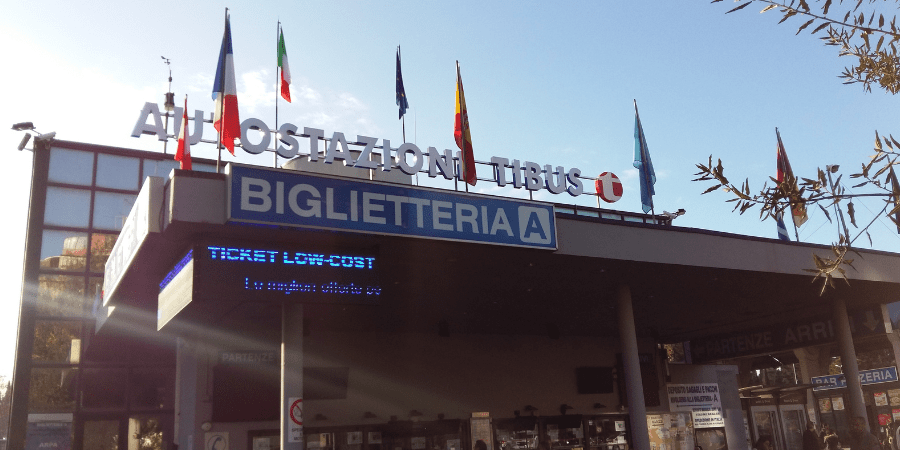
However, there can be some issues with delays, so it’s best to take an early departure, ideally between 8 am and 9 am, to make the most of your day. These buses sometimes travel onward to Sorrento, offering a chance to explore another beautiful destination before returning to Rome around 6 pm.
Driving from Rome to Pompeii
The best flexibility for your Rome to Pompeii day trip is driving, which lets you see the sites at your own speed. The journey from Rome to Pompeii is about 241 km (or 150 miles) and takes approximately 2.5 hours. Keep in mind that there are tolls along the way, and driving is on the right-hand side of the road.
Many car rental companies, including Avis, Enterprise, Europcar, Hertz, and Sixt, offer competitive rates, starting at around £16 per day. If you prefer not to rent a car, BlaBlaCar can be a faster alternative to buses in some cases.
By choosing the right transport method for your trip, you can save both time and money, making your visit to Pompeii a memorable part of your Italian adventure.
What’s the quickest way to get from Rome to Pompeii?
The journey from Rome to Pompeii is a unique experience, offering various ways to explore Italy’s rich history. The train is often the favourite choice for many, especially since the introduction of a direct high-speed train.
The trip takes just 2 hours, making it a convenient and efficient way to travel, but it’s important to note that this special train only runs every third Sunday of the month. If you’re planning your day trip around this schedule, make sure to plan ahead.
If the high-speed train isn’t an option, a train with a connection in Naples or Salerno will take a bit longer around 30 minutes more, but it’s still a relatively quick option.
For those who prefer more flexibility, taking a car is the second-fastest choice. This drive, which mainly uses the A1 and A3 motorways, spans 2.5-3 hours depending on the traffic conditions. This route also gives you more control over your time, allowing for scenic stops along the way. However, be mindful of potential traffic jams, especially near the larger towns.
How far is Pompeii from Rome?
The distance between Rome and Pompeii is approximately 240-250 km (around 149-155 miles) when you travel by road. The journey time varies depending on the type of transport and the specific route you take, but on average, it takes around 2.5-3 hours. The time can vary based on factors such as stops along the way or changing road conditions.
Despite the fluctuating journey times, it’s a relatively short trip, making it a perfect day trip from Rome. For those looking for a carefree trip full of unforgettable experiences, the journey itself is part of the adventure, offering a glimpse of the beautiful Italian countryside.
Visiting Pompeii from Rome: A Full-Day Itinerary
A visit to Pompeii offers an incredible opportunity to walk through an ancient city frozen in time after the catastrophic eruption of Mount Vesuvius in 79 AD. This guide provides an itinerary covering the top attractions in Pompeii and nearby hidden gems, ensuring you make the most of your day trip.
8:00 AM – Depart from Rome to Pompeii
Start your day early with a comfortable train or bus ride from Rome to Pompeii. The journey will take around 2.5 to 3 hours, so plan for a quick breakfast on the go and be ready to begin your exploration by 10:30 AM.
10:30 AM – 11:30 AM: Foro de Pompeya (The Forum)
Your first stop in Pompeii is the Forum, the social, political, and economic heart of ancient Pompeii. The Forum is a large open space surrounded by important buildings like the Temple of Jupiter and the Forum Baths.
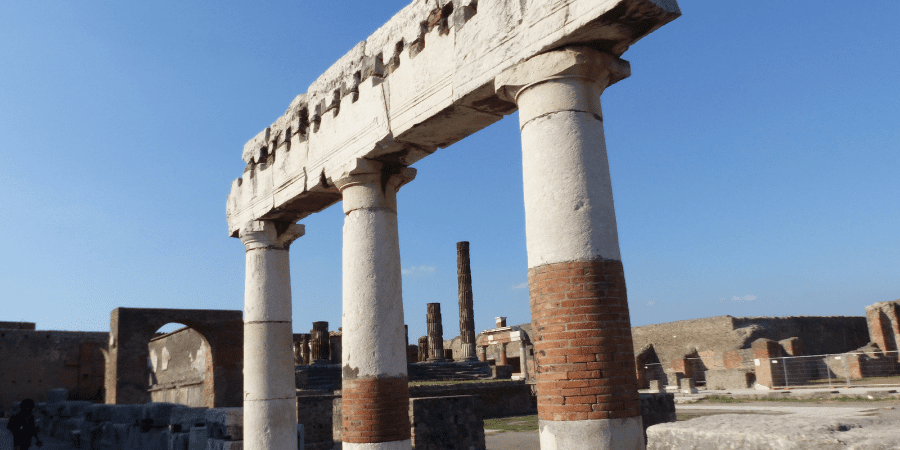
As you walk through, imagine the bustling activities that took place here, from markets to public gatherings.
11:30 AM – 12:00 PM: Temple of Jupiter
Located at the north end of the Forum, the Temple of Jupiter was a central place of worship. With Mount Vesuvius as a dramatic backdrop, this site provides an excellent photo opportunity.
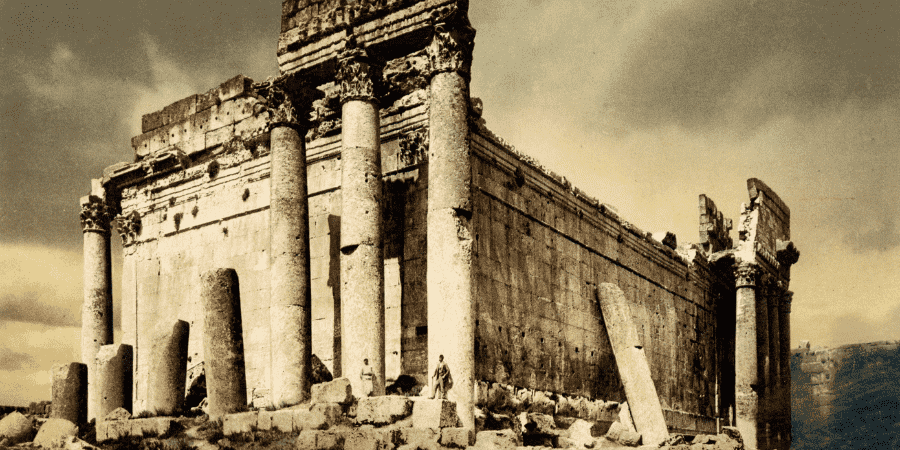
Although damaged by the earthquake of 62 AD, the temple’s remains give a glimpse into its once-impressive architecture.
12:00 PM – 12:30 PM: The Forum Bath
The Forum Baths are well-preserved examples of public bathing facilities in ancient Rome. These baths include separate areas for men and women, with cold and hot baths, and showcase the advanced engineering of the time.
The intricate heating system used warm air circulated through pipes, demonstrating the sophistication of Roman engineering.
12:30 PM – 1:15 PM: Pompeii Amphitheater
Next, head to Pompeii’s Amphitheater, one of the oldest surviving Roman amphitheaters, dating back to 80 BC. It hosted gladiator combats and events with wild animals, drawing crowds of spectators.
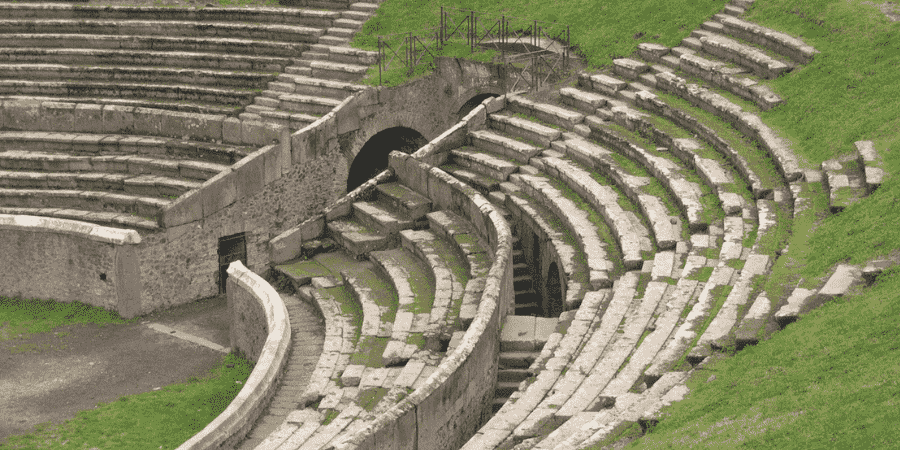
The structure is less crowded than its counterpart in Rome, allowing you to explore the arena at your own pace.
1:15 PM – 2:00 PM: Villa dei Misteri (The Villa of the Mysteries)
From the amphitheater, make your way to the Villa dei Misteri, famous for its well-preserved frescoes depicting initiation rituals of a mysterious cult.
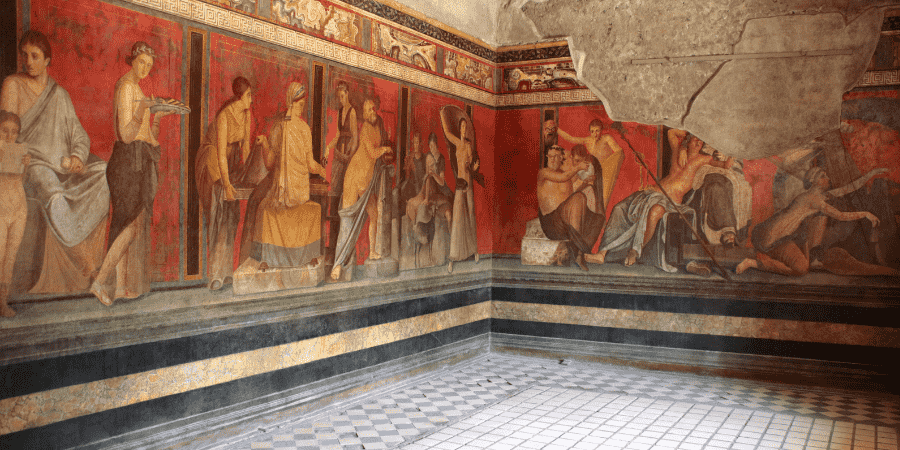
The vibrant wall paintings provide insight into the spiritual and social practices of ancient Pompeii. The villa’s expansive rooms and artistic details make it a must-see attraction.
2:00 PM – 3:00 PM: Lunch Break
Take a break and enjoy lunch at one of the local cafes or restaurants near the entrance to the archaeological site. A hearty meal will keep you energized for the remainder of your exploration.
3:00 PM – 3:45 PM: House of the Faun
After lunch, head to the House of the Faun, one of Pompeii’s largest and most luxurious residences. The house is named after the bronze statue of a dancing faun found in its courtyard.
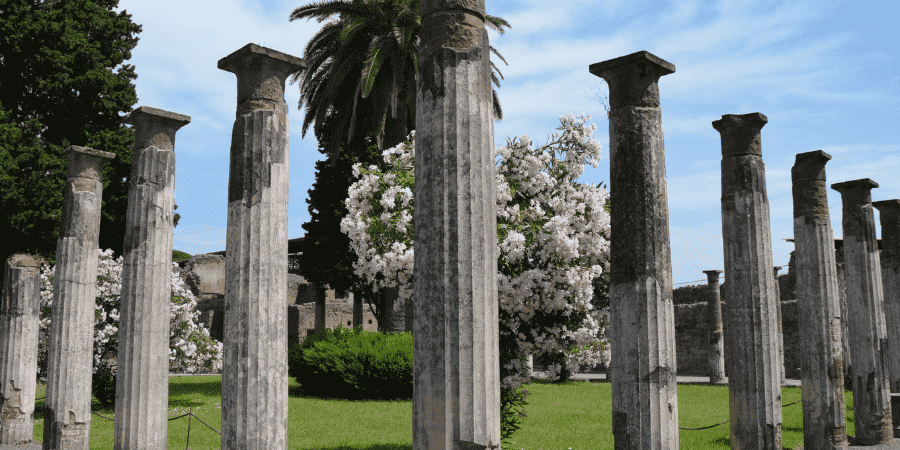
The house features beautiful mosaics, including the famous Alexander Mosaic, which is now displayed at the Naples Archaeological Museum. Explore the rooms and courtyards of this wealthy home, offering a glimpse into Pompeii’s upper-class life.
3:45 PM – 4:30 PM: Garden of the Fugitives
The Garden of the Fugitives is a poignant reminder of the tragic end that befell the residents of Pompeii. Here, you can see the plaster casts of victims caught in the eruption, capturing their final moments.
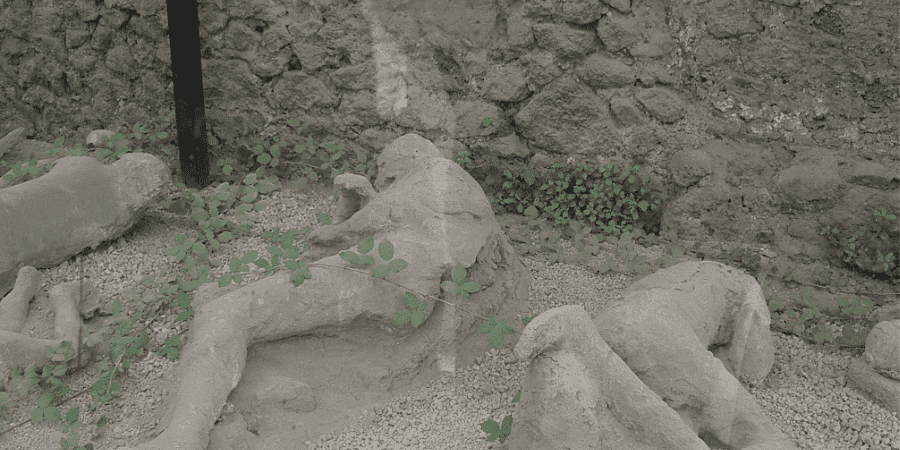
Recent DNA testing revealed that some of the victims were related, adding a personal touch to this tragic scene.
4:30 PM – 5:00 PM: Stabian Baths
Next, visit the Stabian Baths, among the oldest and most complete thermal baths in Pompeii. The baths feature separate sections for men and women, with facilities for cold, tepid, and hot baths. Adorned with stunning stuccoes, these baths showcase the advanced heating techniques of the time.
5:00 PM – 5:30 PM: House of Julia Felix
The House of Julia Felix is a large villa with a central garden and beautifully preserved frescoes. After the earthquake of 62 AD, parts of the house were rented out, offering a glimpse into the adaptive reuse of properties in ancient times.
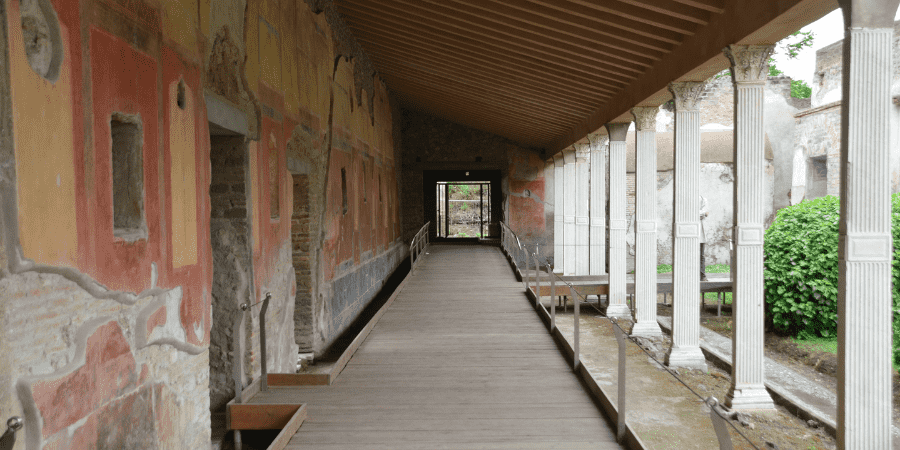
The site’s intricate wall paintings and residential layout provide insights into daily Roman life.
5:30 PM – 6:00 PM: Optional Extra: Visit Herculaneum or Oplontis (If Time Allows)
If time allows, consider taking a quick 20-minute drive to Herculaneum, a neighboring town that was also buried by the eruption of Mount Vesuvius.
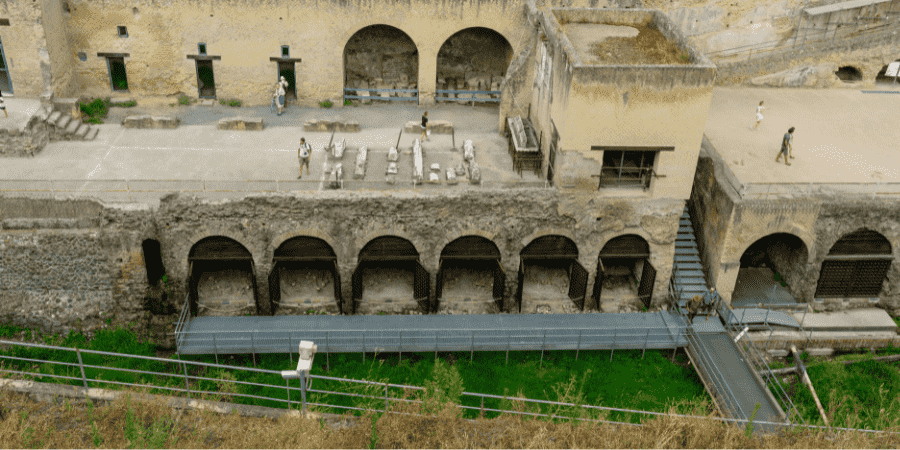
Herculaneum is smaller than Pompeii but offers excellent preservation, including carbonized wood, papyrus scrolls, and even food items. The intimate streets and well-preserved buildings provide a more personal look at Roman life.
Alternatively, you could visit Oplontis, famous for its grand Roman villas buried under volcanic ash. Excavations revealed stunning frescoes and human remains, highlighting the dramatic impact of the eruption.
Visit Villa Poppaea (Villa A), believed to have belonged to Emperor Nero’s wife, Poppaea. This luxurious villa features elaborate wall paintings and a massive swimming pool.
6:00 PM – 6:30 PM: Return to Rome
After a full day of exploration, it’s time to head back to Rome. Depending on your departure point, you can catch a bus or train to make your way back, arriving in the evening.
Surrounding Areas (Hidden Gems Outside Pompeii)
Extend your trip beyond Pompeii to explore nearby archaeological sites that offer equally fascinating experiences without the crowds.
Stabiae
The Stabiae area is known for its elegant seaside villas, offering spectacular views and remarkable artifacts. The Villa San Marco and Villa Arianna are the main highlights, featuring stunning mosaic floors and well-preserved frescoes. These sites are less crowded, making them ideal for a quiet exploration of Roman architecture.
- Villa San Marco: One of the largest and best-preserved villas in Stabiae. Its expansive layout includes gardens, pools, and beautifully decorated rooms. The villa’s frescoes and intricate designs offer a glimpse into the luxury enjoyed by the Roman elite.
- Villa Arianna: Named for the fresco depicting the myth of Ariadne, Villa Arianna is another stunning example of Roman residential architecture. The villa features grand courtyards, vibrant wall paintings, and extensive views of the Bay of Naples.
Oplontis
Visit Oplontis to explore Villa Poppaea (Villa A), a luxurious Roman villa featuring elaborate wall paintings and a massive swimming pool. The site provides insight into the opulent lifestyle of ancient Roman elite.
Famous Cuisine and Foods to Try in Pompeii
When visiting Pompeii, the local food is a highlight of the trip. The region is known for its Mediterranean and Neapolitan culinary influences. Here are some of the famous dishes and local specialties you should try during your visit:
Antipasto Platter
An essential start to any meal in Pompeii is the antipasto platter, which typically includes fried tiny fishes, algae batter, potato croquettes, grilled vegetables, and local cheeses like buffalo mozzarella and ricotta.

You will also find Neapolitan salami and a variety of cold cuts. This assortment gives you a delicious taste of the local flavors.
Pasta di Gragnano
This famous pasta from Gragnano is often paired with seafood like seaweed, fish, or octopus. It’s a hearty and flavorful dish, offering the perfect taste of the region’s coastal influence.
Gnocchi alla Sorrentina
Another iconic dish is gnocchi alla Sorrentina, where dumplings are served in a rich tomato sauce with mozzarella. This dish is a must-try for anyone looking to experience the classic comfort food of the area.
Grilled Fish
For the second course, try the grilled or roasted fish, which is typically fresh and locally sourced, offering a perfect taste of the sea.
Neapolitan Desserts
Pompeii also offers some delightful desserts. Enjoy caprese, a rich chocolate cake, or wheat tarts.
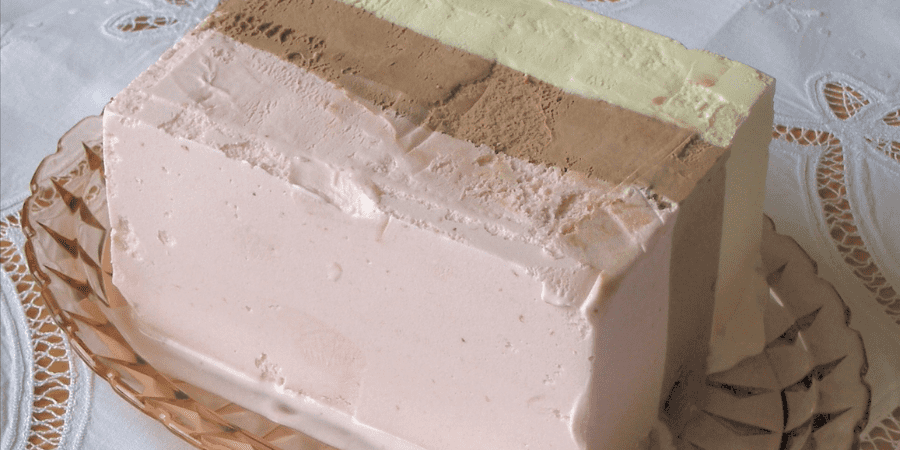
You must also try the famous babà, a small cake soaked in rum, and sfogliatelle, the signature shell-shaped pastries filled with ricotta.
Traditional Fried Dough
If you’re visiting during Carnival or around Saint Joseph’s Day (March 19th), don’t miss out on struffoli and zeppole, which are deep-fried dough balls. These traditional treats are a fun, sweet part of the cultural experience.
Pizza
No visit to Pompeii would be complete without tasting pizza, as the city is just a short distance from Naples, the birthplace of the world-famous pizza. It’s said that the pizza of Naples is unbeatable, and you will find no better place to enjoy a delicious, authentic slice.
With these iconic dishes and drinks, your Pompeii trip will be a feast for both your eyes and your taste buds.
Additional Must-Try Regional Delights
- Pomodorini di piennolo (Vesuvian tomatoes)
- Neapolitan bagels (with black pepper and almonds)
- Casatiello (stuffed Easter bread)
- Panuozzo (thin-bread sandwiches from Gragnano)
Top Tips for an Unforgettable Rome-to-Pompeii Day Trip
- Start early to avoid crowds and maximize your day.
- Book transportation and tickets in advance.
- Pack essentials: sunscreen, hat, water, comfortable shoes.
- Decide between self-guided exploration or a guided tour.
- Wear sturdy, comfortable footwear for uneven terrain.
- Plan your route inside Pompeii to see key sites.
- Consider a combined Pompeii and Mount Vesuvius tour.
- Take breaks and enjoy the atmosphere.
- Pack light and bring only essentials.
- Enjoy a local meal, preferably outside the ruins for better prices.
- Avoid tourist traps and overpriced souvenirs.
- Check return transport schedules to avoid delays.
Touring Pompeii: Self-Guided or Guided?
When planning your Rome to Pompeii day trip, you have two main options: self-guided or guided tour. Each offers a different experience depending on your budget, interests, and travel style.
Self-Guided Tour: Pros and Cons
Pros
- Budget-friendly: Saves on tour costs.
- Flexibility: Explore Pompeii at your own pace, enjoy photos, and visit nearby towns like Naples or Sorrento.
- Freedom: Choose which attractions to prioritize and visit Vesuvius or nearby areas without time restrictions.
- Leisurely breaks: Stop at local restaurants and spend longer periods at less crowded ruins.
Cons
- Requires more planning: Organizing tickets, maps, and an itinerary can be overwhelming for first-timers.
- Inconvenient public transport: It may be hard to navigate the site or reach it by public transport.
- Missing historical insights: Lack of a guide means missing important details and lesser-known stories.
- Challenging navigation: The expansive ruins can be difficult to explore without expert direction.
- Limited facilities: Lack of secure luggage storage or other amenities available on guided tours.
Guided Tour: Pros and Cons
Pros
- All logistics sorted: Includes transport, priority entry, and often meals at local Italian restaurants or vineyards.
- Expert guidance: Learn from an expert guide who shares historical insights and lesser-known facts.
- Exclusive experiences: Access to special-access areas not available on self-guided tours.
- Convenience: Includes luggage storage and other facilities.
- Social opportunities: Great for solo tourists seeking social interaction with like-minded travelers.
Cons
- Fixed schedule: You may feel rushed and unable to linger in areas that interest you.
- Limited flexibility: The itinerary is set, preventing spontaneous exploration.
- Large groups: Group sizes might reduce the personal nature of the experience.
- Strict return times: May miss out on further exploration or discoveries outside of the scheduled time.
Final Thoughts
The trip from Rome to Pompeii provides an opportunity to travel through time. An amazing experience is offered by the contrast between the ancient Pompeii remains, which were preserved by Mount Vesuvius’ eruption, and Rome’s modern liveliness. For those who enjoy history, this trip provides an opportunity to visit one of the most intriguing archaeological sites in the world and gain a deeper understanding of Roman civilization.
For more amazing travel ideas, check out our Things to Do in Verona, Italy and tips on Visiting the Cinque Terre Towns in 2 Days if you’re planning additional adventures in Italy.

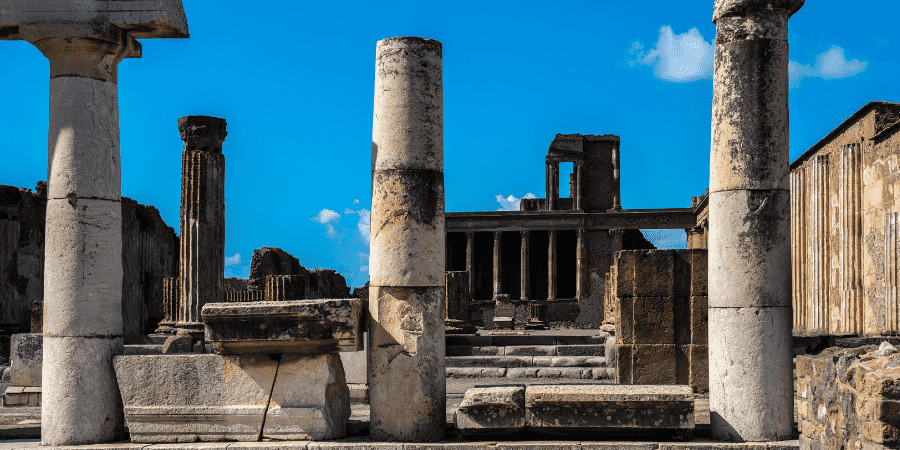
No responses yet